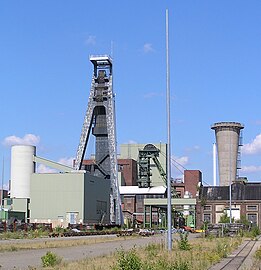Lippe mine
| Lippe mine | |||
|---|---|---|---|
| General information about the mine | |||
|
Location Prince Leopold , Dorsten |
|||
| Funding / year | last approx. 8000 t | ||
| Funding / total | 250 million tons | ||
| Information about the mining company | |||
| Employees | last 2900 | ||
| Start of operation | circa 1900 | ||
| End of operation | December 19, 2008 | ||
| Funded raw materials | |||
| Degradation of | Hard coal | ||
| Geographical location | |||
| Coordinates | 51 ° 36 '7 " N , 7 ° 4' 33.3" E | ||
|
|||
| Location | Hassel | ||
| local community | Gelsenkirchen | ||
| Independent city ( NUTS3 ) | Gelsenkirchen | ||
| country | State of North Rhine-Westphalia | ||
| Country | Germany | ||
| District | Ruhr area | ||
The Lippe mine was a mining coal mine in the northwestern Ruhr area . The administrative seat is in Gelsenkirchen . Its components were the conveyor - conditioning - and administration site Westerholt, the former production site Prince Leopold, who Seilfahrt location Polsum and the ventilation shaft Altendorf. On December 19, 2008, the Lippe mine ceased operations.
Mining history
The mine field of the Lippe mine lay under the cities of Gelsenkirchen , Herten , Marl , Haltern , Dorsten , Bottrop and Gladbeck . It was created in 1998 through the merger of the formerly independent mines Westerholt and Fürst Leopold / Wulfen as part of several adaptation measures by Deutsche Steinkohle AG (DSK). The shafts Westerholt1 / 2/3, Polsum 1 and 2, Altendorf , Fürst Leopold 1/2, Wulfen 1/2 and Baldur 1 were received . The mine owes its name to its location on the Lippe river .
Extensive adjustment and rationalization measures were carried out. The Fürst Leopold 1/2 shafts were closed for extraction and kept open for cable travel and weather control . Subsequently, the raw coal extraction was concentrated on the Westerholt 3 shaft and the passenger ropeway on the 1 shaft. The Westerholt 2 shaft, which was no longer needed, was dropped and filled . In 1999 the Hassel coking plant , which was a former part of the Westerholt / Bergmannsglück mine, was shut down.
This was followed by the gradual abandonment of the northern part of the field, Wulfen. The planned Wulfen 3 shaft was shelved. In 2001 the Wulfen 1/2 shafts were backfilled and these mining facilities were completely demolished "in the countryside". In 2002 the Baldur 1 shaft was also filled . Most recently, the Lippe mine comprised the shafts Westerholt 1/3, Polsum 1, Polsum 2, Altendorf (in the areas north and south of the Altendorf weather shaft) and Fürst Leopold 1/2.
The excavation from the total of 70 km long pits was fully mechanized. Around 250 million tons of coal have been mined since mining began at the turn of the 19th and 20th centuries. Most recently, around 8,000 tons of coal per day were mined by the 2,900 employees in 2 mining operations. On March 28, 2008, a resolution by the RAG Supervisory Board on April 2 stipulated an early funding stop for December 2008. This decision was favored by the compromise to continue operating the Saar mine until 2012.
literature
- Joachim Huske: The coal mines in the Ruhr area. 3rd edition, self-published by the German Mining Museum, Bochum 2006, ISBN 3-937203-24-9

